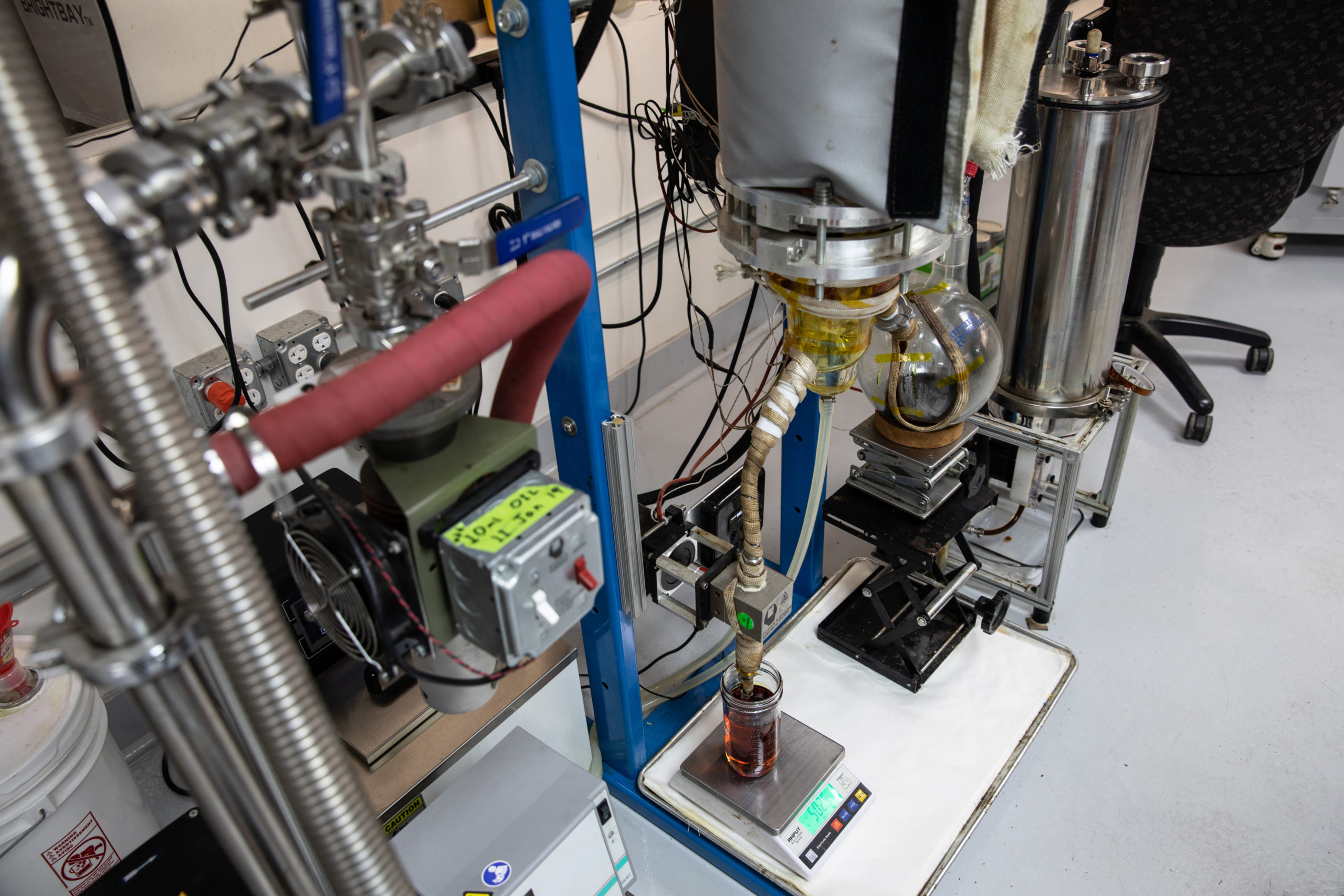Throughout history, grain alcohol has been a preferred solvent for botanical extractions. It is, by no means, a new science. Our ancestors were soaking cannabis in pure alcohol for both medicinal and recreational purposes; mainstream cannabis culture only just caught up with their herbalism.
That is to say, recreational legalization made methods of consumption typically reserved for pharmaceutical renegades available to the average consumer, and now extractions have become commonplace. Most dispensaries have at least one menu page dedicated to concentrates, and tinctures and salves have become fixtures in medicine cabinets nationwide. But to the uninitiated, the science of extraction can still present something of an intellectual mystery.
 Photo by: Gina Coleman/Weedmaps
Photo by: Gina Coleman/WeedmapsImage lightbox

For example, have you ever wondered what the efficacy difference is between an MCT oil vs an ethanol-based tincture? Or why some extractions look like inky tar while others are crystal clear? Or perhaps you've questioned the virtue of cannabis that's been rinsed in what's commonly known as Everclear. To the marijuana layperson, casual user, or even the dedicated flower burner, these are all valid questions. Albeit with pretty easy answers.
What does ethanol extracted mean?
Ethanol is a term that describes pure naphtha, isopropyl, or grain alcohol. Ethanol extractions are produced by soaking, rinsing or running ethanol through cured plant matter, then separating the plant matter from the alcohol and either evaporating or purifying the remaining liquid. The resulting mixture is a concentration of the psychoactive and medicinal compounds produced by the cannabis flower.
 Photo by: Gina Coleman/Weedmaps
Photo by: Gina Coleman/WeedmapsImage lightbox

Ethanol extraction is most popular as a method for producing tinctures, full extract cannabis oil, and Rick Simpson Oil.
Why is ethanol used for extraction?
Ethanol's composition makes for an extremely effective solvent when it comes to the extraction of oil from plant matter. Alcohol is a solvent that's been used throughout recorded history to extract essences from pharmaceutical botanicals. In fact, ethanol tinctures of cannabis were listed in the American Pharmacopeia of 1851.
Cannabinoids are soluble in ethanol at a 1:1 ratio which is to say that 1g of THC is soluble in 1mL of ethanol. Rinsing the active agents from the plant retains the aromatic compounds while rendering the plant matter expendable, thereby both concentrating the potency of the cannabinoids and making them accessible to a wide swath of users.
Is ethanol extraction safe?
The FDA has long regarded ethanol as generally safe for human consumption. It's a common food additive used for many processed foods and can be seen on many ingredient lists.
Furthermore, ethanol extractions are — for the most part — safe enough to produce on your own stovetop and have been for several generations. While butane, propane, and CO2 extractions all require significant machinery, handling, and safety protocols, grain alcohol can be purchased at your local bottle shop and can do just as an effective job of concentrating cannabinoids.
Essentially, since common sense and ventilation are all that's required to produce an ethanol extraction worthy of ingesting, it could be argued that ethanol is, in fact, one of the safest solvents for extractions.
Are there any downsides?
Ethanol's polarity presents the most challenging aspect of its efficacy as a solvent. Ethanol is a polar solvent, meaning it does an exceptional job not just of separating plants from their oily essences, but also of dissolving water-soluble molecules such as chlorophyll. Commercially produced ethanol tinctures will perform a multitude of costly extra steps to purify and clarify their final product, but home extractions will almost certainly have a telltale dark coloration and a bitter, earthy flavor.
From a different perspective, ethanol's polarity allows for more full-spectrum extractions. The incorporation of botanical compounds that would otherwise be lost to post-processing can add another dimension to cannabis' entourage effect, making ethanol the preferred solvent for many dedicated extractors, both personal and commercial.
Home extractors uninterested in a multi-step purification process or adverse to the heady fumes of evaporating alcohol may prefer oil-based extractions. Conversely, home extractors committed to a literal full-spectrum extraction are unlikely to find as nuanced a final product as one produced with ethanol.
How does ethanol extraction compare to CO2 extraction?
Process-wise, CO2 extraction is actually similar to ethanol extraction. Both methods essentially wash away trichomes, breaking down the plant matter in the process. What makes CO2 extraction unique, aside from its relative newness compared to most methods of extraction, is in its compression, which renders it a supercritical fluid — aka both a liquid and a gas. In this state, it breaks down all plant matter, creating a slurry that requires complex post-processing before it's suitable for use.
Ethanol extractions also break down water-soluble molecules, resulting in a co-extraction of sorts, but post-extraction, the active cannabinoids can be separated from their source plants with nothing more than a sieve. And while ethanol extractions do not result in a “slurry” per se, post-extraction evaporation of the alcohol does create a thick, tar-like concentrate, commonly known as full-spectrum cannabis oil, FECO, Rick Simpson Oil (also known as RSO or Phoenix Tears).
Bottom line
Ethanol extractions are a relatively simple and safe way to consume concentrated cannabis.

